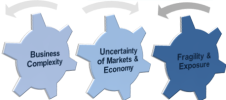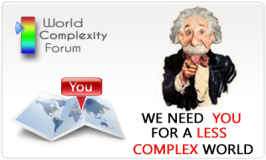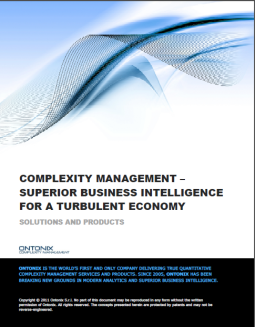World Economic Forum: Global Risks 2010 – complexity perspective
Wednesday, 27 October, 2010 Leave a comment
The Annual WEF: Global risks report always makes interesting reading but, from a “complexity perspective” this year is of particular interest to us at Ontonix. Of course that is not to say that this is the full extent of the interest! It really gets meaningful when we are able to work with clients to tackle the issues that have been identified.
I have endeavoured to convey in the above graphic the inter-connections between the various domains. As we know, but sometimes forget, more life exists outwith the Economic domain than in it. Hold that thought. Keep it with you. Because interdependence is encoded in what makes and keeps us ALL.
SO, please take the time to read these extracts that, in one way or another, reference risks arising and/or increasing as a result of the “complexity” that comes from inter-connectedness.
The messages are there for corporations to see but, it is very clear that, unless the carriers of financial and insurance risk proactively tackle the task of providing solutions they will fail their global clients, shareholders, reinsurers, investors, etc.
Attempting to resolve 21st century risks with 20th century tools and techniques can only have one outcome.
Cross-cutting themes
Three themes provide the backdrop for discussion in this report. As the first chapter discusses, the increase in interconnections among risks means a higher level of systemic risk than ever before. Thus, there is a greater need for an integrated and more systemic approach to risk management and response by the public and private sectors alike. Second, while sudden shocks can have a huge impact, be they serious geopolitical incidents, terrorist attacks or natural catastrophes, the biggest risks facing the world today may be from slow failures or creeping risks. Because these failures and risks emerge over a long period of time, their potentially enormous impact and long-term implications can be vastly underestimated.
The Global Risks 5i Framework applied to transnational crime and corruption
Insight: Crime and corruption thrive on the increasing complexity and opacity of supply chains and global markets. While various actors and institutions have visibility into segments of the chain, most often they lack the complete overview of the chain and interactions within it. Forward-looking risk management must therefore identify these interlinkages and account for the entire sequence of exchanges from the source to the distribution to end customers, identifying the trading routes and facilitators connecting each step.
Critical Information Systems and Cyber vulnerability
Modern industrial societies are highly dependent on a limited number of utilities that provide electricity, water, oil and gas. In the past, the information systems controlling the infrastructure underlying these utilities typically consisted of closed, completely private networks managed from a single control centre, with only limited attention given to authentication or encryption issues. These proprietary networks, however, were expensive to run while the open, Internet Protocol-based networking standards offered substantial cost-saving prospects, which led engineers to connect the control systems to the Internet across utilities and other industry sectors around the globe over the last decade. With the emergence of cloud computing, a new era of complexity and risk is opening up. By its very nature, cloud computing will make risks more diffuse and, thus, their management more difficult. Cloud computing is a new system, but it will link to numerous existing, critical systems. In many ways it could be comparable to the financial system, global but with relatively little international oversight, and critical to the functioning of economies and societies. Cloud computing can bring many opportunities but in the absence of adapted models of governance and regulation it could also bring a new degree of vulnerability and systemic risk.
The increasing complexity and rapid development of dynamic systems and networks, the sophistication of changing threats and the presence of intrinsic vulnerabilities present demanding challenges to the information society. As network systems grow larger and ever more interconnected, the risk includes large system failures due to human error or lack of effective governance of digital assets. Technological, societal and economic incentives therefore need to become aligned to reduce the rapidly increasing risks of cybercrime, data fraud/loss, and CII system failure. This is particularly important at a time when a serious incident could have a severe impact and as technological systems represent a decisive factor for growth and development.
Opportunities in complexity
Global Risks 2010 emphasizes that the interconnections among risks can help management teams challenge themselves to develop a more robust scenarios. The report’s tools, such as the Global Risks Barometer and Risk Interconnections Map (RIM) highlight the trends and connections between emerging risks and underlying drivers in risk volatility.
Taken together, these insights can help broaden the scope of trends that are considered and help management question the long-term underpinnings and assumptions about their supply chains and the competitive landscape. As noted above, corporations must assess how risks might directly or indirectly affect the organization as a participant in a globally competitive marketplace and as a member of a global supply chain. This information must be factored into planning scenarios.
The report’s focus on the changing risk landscape can also be used to identify emerging opportunities in markets or sources that could provide the corporation with a competitive edge. It has become a truism to note that all corporations now operate in a global economy. Reports, such as the Global Risks reports, provide corporate management with valuable long-term, external insights into the events that might impact the success of strategic plans, the performance of the overall supply chain and the emerging opportunities embedded in a complex, interconnected global economy.
As suggested in this report, although the interconnected view of global risks adds greater complexity to decision-making, it is vital in developing effective strategies to manage risks. These interconnections do not always reflect a direct causal relationship, as risks are often linked indirectly through common impacts or mitigation trade-offs. For many of the global risks discussed in this report, the ownership of these risks remains fragmented and unclear, and it is often difficult to identify actors willing and able to take ownership. This, coupled with the complexity of interdependencies, is perhaps why so many of these issues remain endemic and systemic in nature, although their existence and potential impact is known.












